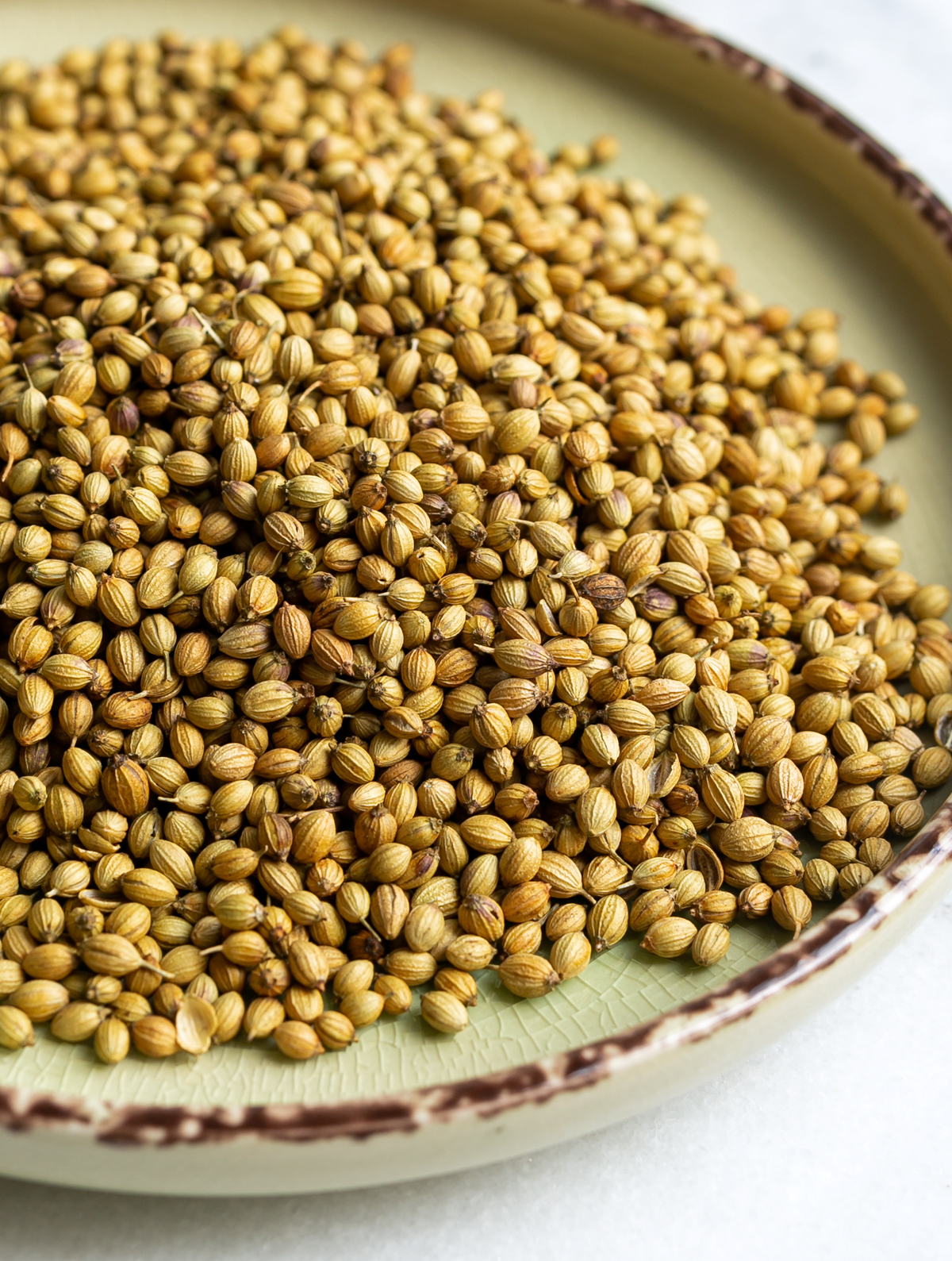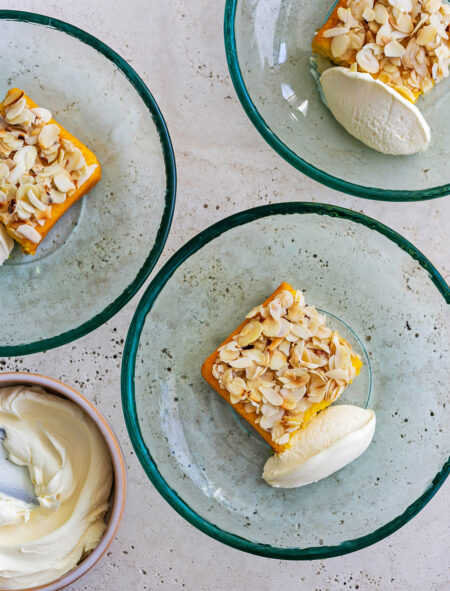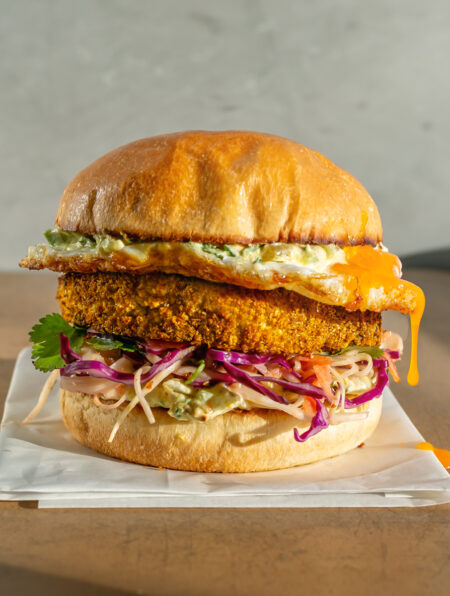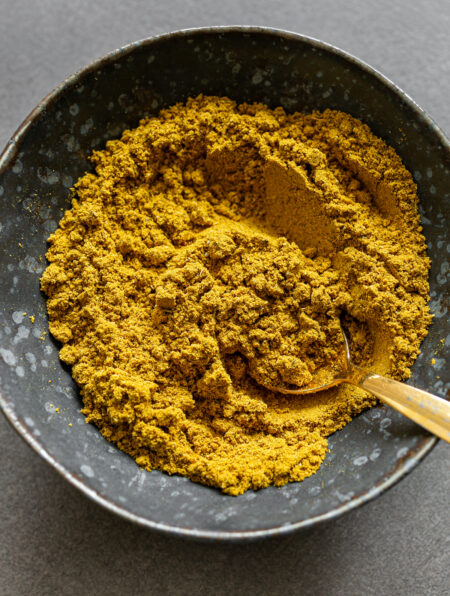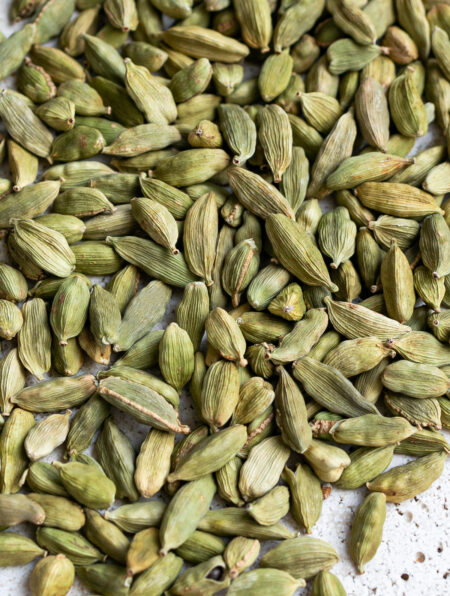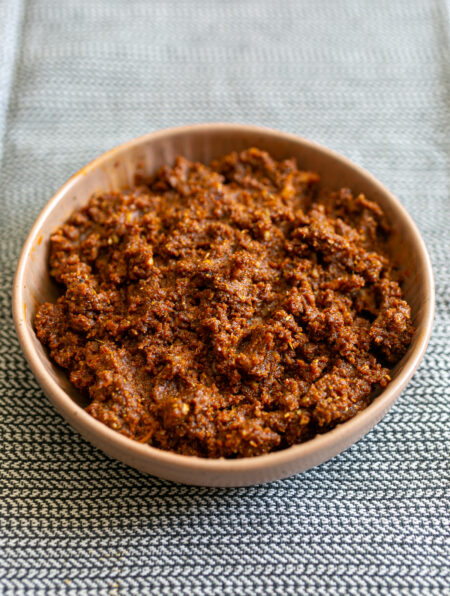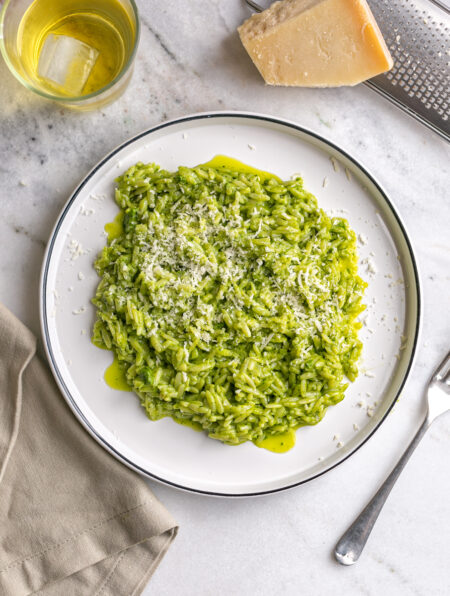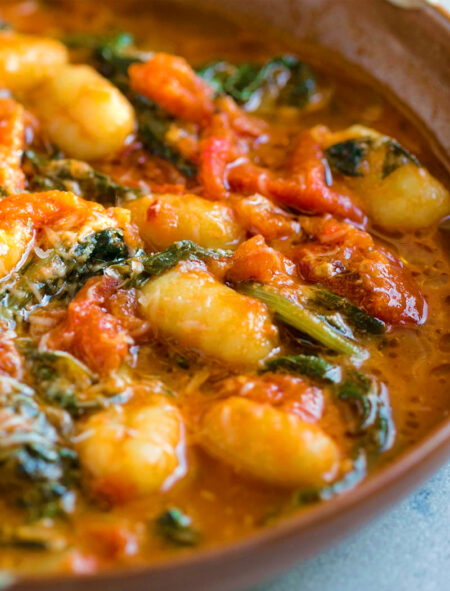
Table of Contents
- What Is Coriander?
- History of Coriander – where did coriander originate from?
- Coriander Seed uses
- The difference between coriander seed, leaf and root
- What is Coriander Leaf used for?
- What is Coriander Root used for?
- What do coriander seeds taste like?
- Cooking with coriander seeds
- Do coriander seeds soften when cooked?
- Toasting coriander seeds
- Coriander Flavour Pairings
- Everyday ingredients that pair with Coriander
- Other uses for Coriander
- Coriander Seed Substitute
- Recipes using Coriander
What Is Coriander?
Coriander is a spice and herb derived from a plant with the botanical name Coriandrum sativum, a member of the parsley family. The entire plant is utilised for its leaves, stems, seeds and roots.
A pink-tinged or white flower develops on the plant which eventually turns into the fruits of the spice, producing small tan-coloured seeds known as coriander seeds. The stalks of the plant are cut before the seeds are fully ripe. The seeds are then removed, cleaned and dried.
History of Coriander – where did coriander originate from?
Native to the Mediterranean and Southern Europe, evidence of its history can be traced back to Isreal and the Egyptian tombs. Greeks and Romans used it as medicine and meat preservative.
Around 2000 years ago the spice travelled to India and Persia and centuries later to China and Anglo-Saxon Britain where it is now mainly used to distil gin and beer. The movement of early European settlers helped transport the spice to North America and many other countries.
Coriander Seed uses
A versatile spice with a bittersweet taste reminiscent of dried orange peel. Cultivated in both Europe and India, the European seeds are more citrusy than the larger oval seeds of the Indian type. They are used during cooking to flavour meat, fish and vegetable dishes as well as being used to enhance salads, pickles, preserves and alcohol.
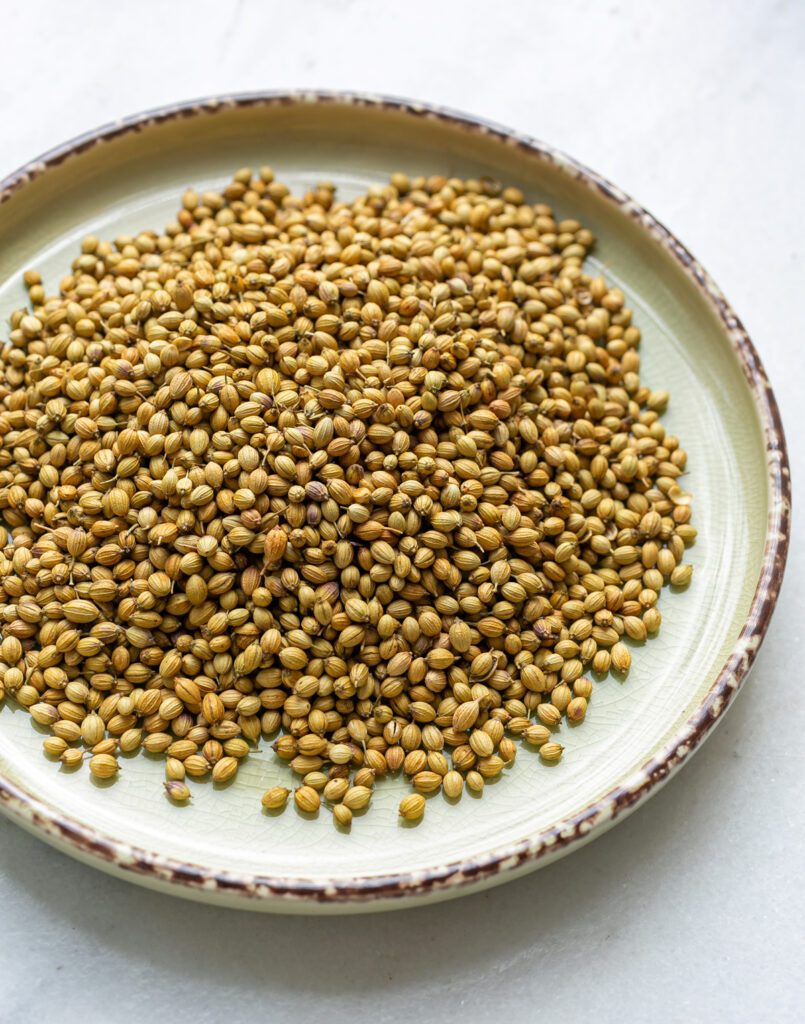
The difference between coriander seed, leaf and root
Coriander is utilized in 3 ways, fresh leaves, root and seeds. Each variant has its own use and flavour and the distinction between the three must be noted when applying to a recipe.
What is Coriander Leaf used for?
Fresh coriander leaves, (also known as cilantro or Chinese parsley), are widely used throughout the world as a garnish on many international and modern fusion dishes. They are also a key ingredient in chutneys and salads, salsa and guacamole, offering a distinctive herbal and floral taste.
Heat diminishes the flavour compound of the leaves so they are specifically used as a raw ingredient and not within the cooking process.

What is Coriander Root used for?
Coriander roots are used in a variety of Asian and Thai cuisines. They have a deeper, more intense flavour than the leaves and are especially useful as an ingredient within freshly made curry pastes, or slow-cooked soups and stews.
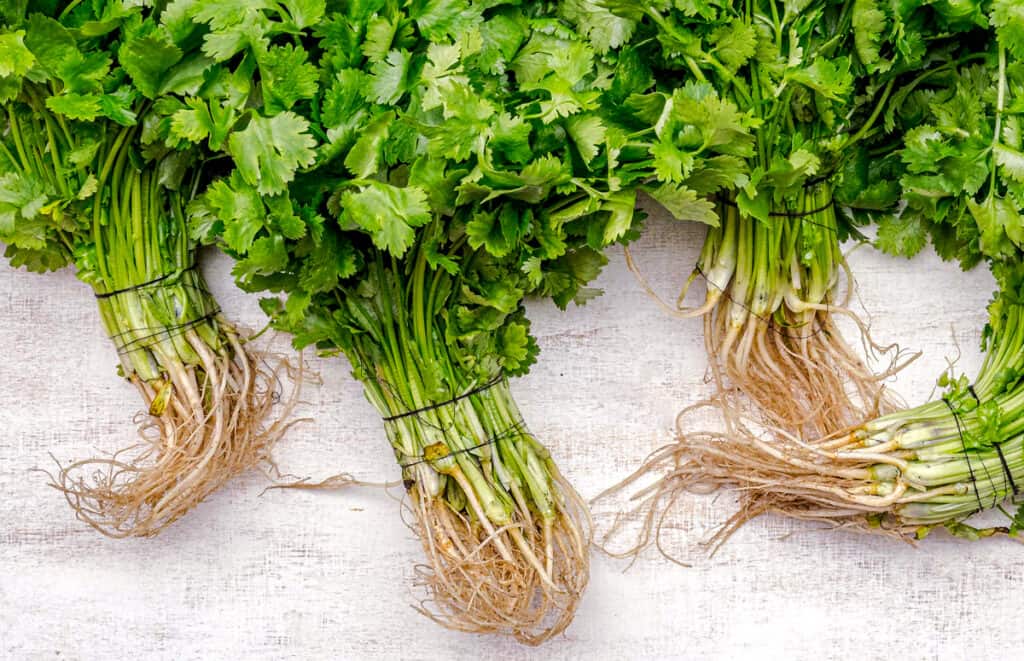
What do coriander seeds taste like?
Floral, citrus and bittersweet. While it is often used on its own in pickle juices, brines, alcohol distils and garnishes, its orange-lemon citrus profile makes it the perfect spice to pair with others such as earthy woody cumin or as an element within other spice blends. Cumin and coriander create a strong pairing that can be added to enhance many international dishes.
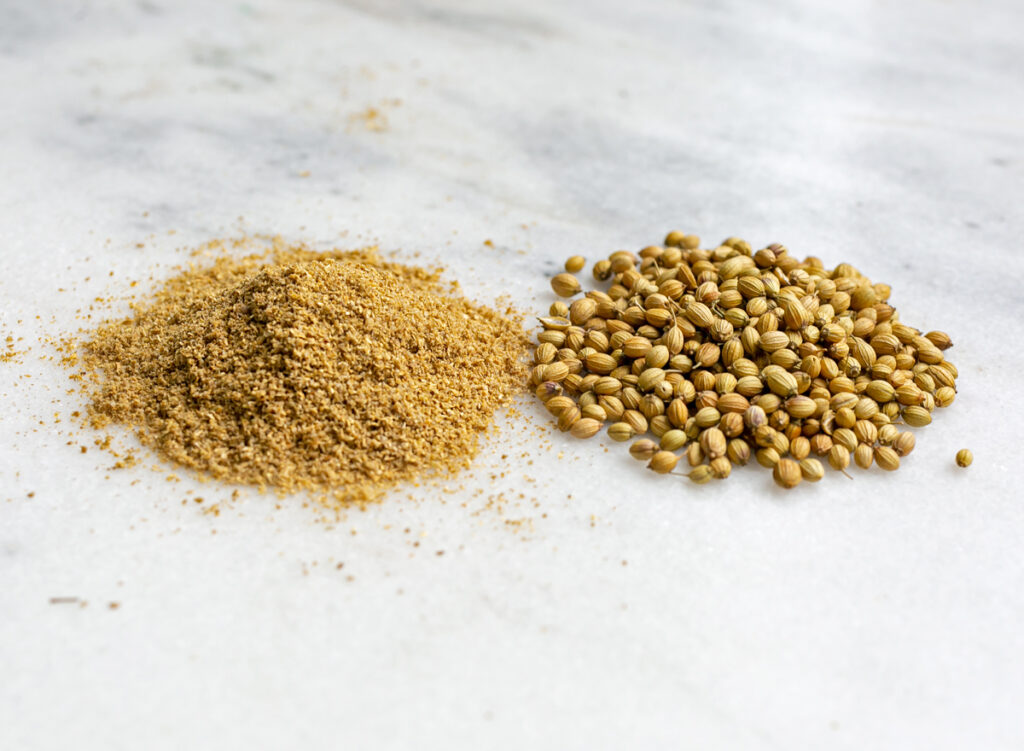
Cooking with coriander seeds
The other option is to gently dry-roast them in a frying pan and grind them down into a powder using a mortar & pestle or electric spice blender. Ground coriander will release its flavour much faster than the seeds, however, its shelf life is limited, losing its aroma and flavour more quickly. For this reason, it’s best to make small batches if planning to keep it jarred and shelved.
Do coriander seeds soften when cooked?
Yes, but it requires a little bit of time. Whole coriander seeds should be added at the beginning of cooking so they have time to soften and release their essence. For example, by adding them at the beginning of making a curry or stew, they will break down as the sauce slowly simmers away.
If you are making a dish with a shorter cooking time, such as some smokey beans or a quick Mexican chilli con Carne and don’t want to taste the crunch of the seeds, dry roast them first and grind them down into a powder. That way the cumin will be instantly absorbed into the sauce.
Toasting coriander seeds
How to toast coriander seeds

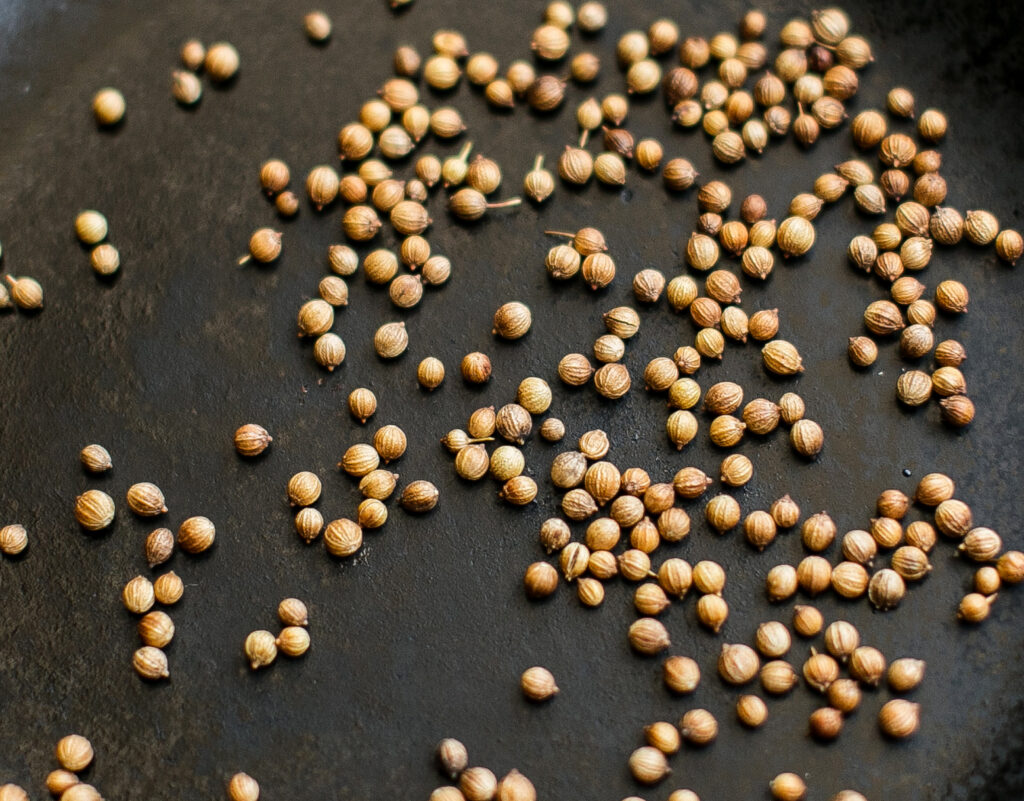
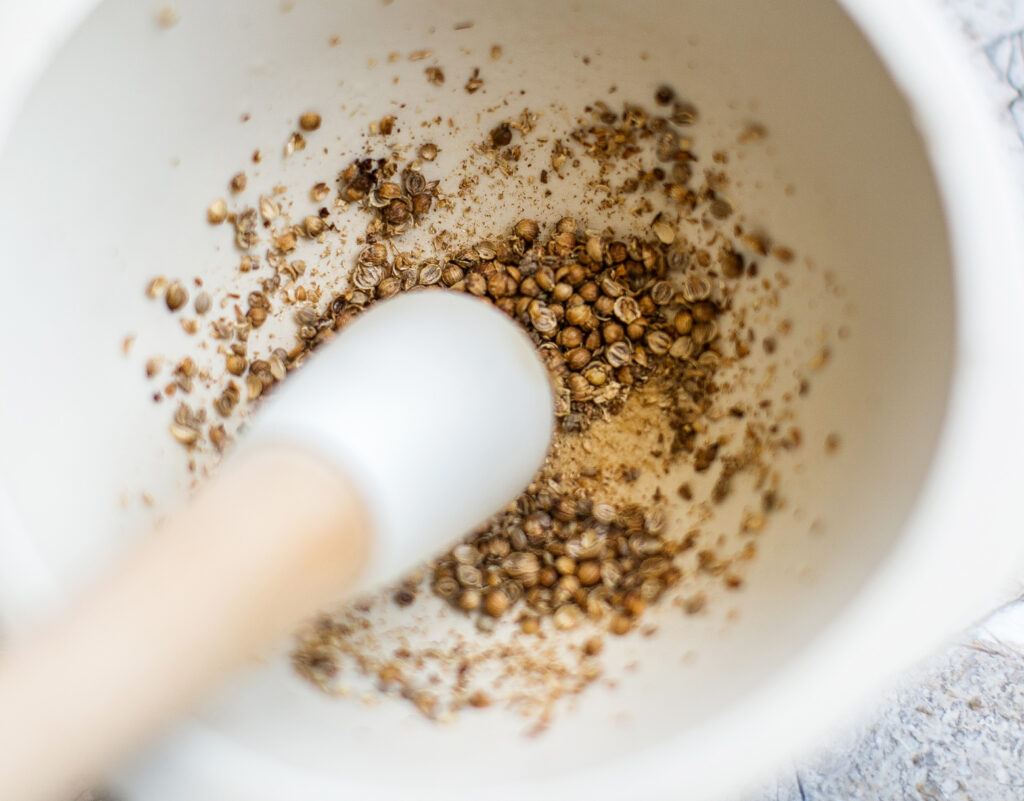
Coriander Flavour Pairings
What spices go with coriander?
Spices that pair with coriander: cumin, cardamom, cloves, mustard seeds, nutmeg, black pepper, anise, allspice ginger, lemongrass, caraway, turmeric, cinnamon, fennel, bay leaf, cayenne pepper, paprika, chilli, saffron, tamarind
Herbs that pair with coriander (fresh and dried)
Oregano, marjoram, parsley, basil, mint, coriander
Popular spice blends using coriander
Harissa, madras curry powder, garam masala, baharat, advieh, hawaij, korma curry paste, vindaloo paste, tikka masala, chaat masala, ras el hanout, dukkah
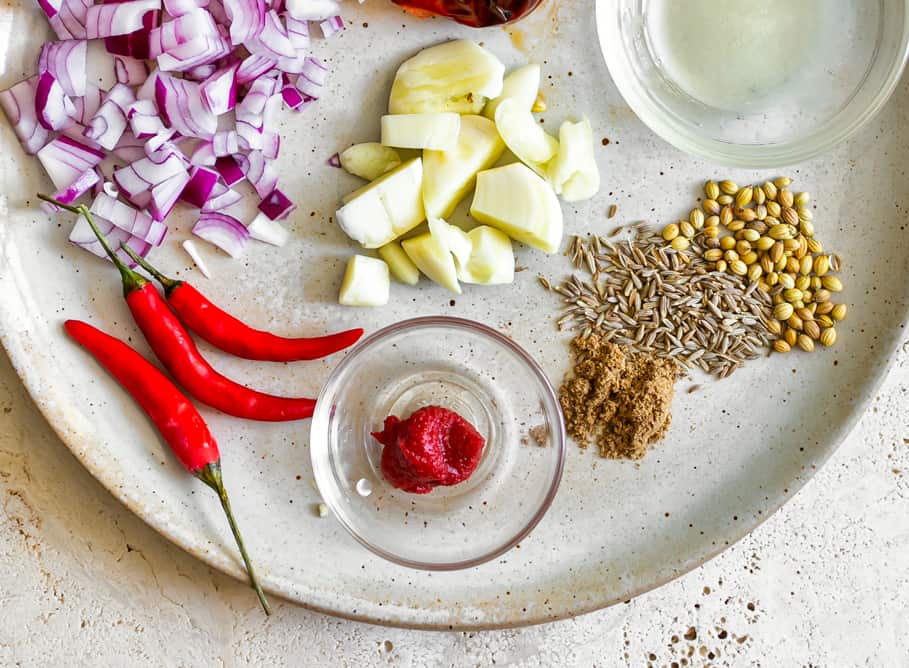
Everyday ingredients that pair with Coriander
- Coriander + Meat: Chicken, turkey, beef, pork, ham, duck, lamb, white fish, salmon, trout, tuna, shellfish
- Coriander + Vegetable: tomatoes, potatoes, sweet potatoes, onions, garlic, fennel, broccoli, cauliflower, beans, celery, cabbage, aubergine, courgette (squash), pumpkin, red green and yellow peppers (paprika), parsnip, carrots, beetroot, bok choy, chilli peppers, corn, mushrooms, cucumber, ginger, vegetable root, peas, chickpeas, lentils, rice
- Coriander + Fruit: lemon, lime, orange, apple, apricots, grapefruit, pear, plums, dates, figs
- Coriander + Dairy: Paneer, ricotta, burrata, mozzarella cheese, feta, halloumi, yoghurt
- Coriander + Nuts: Pistachio, walnuts, cashews, almonds, pumpkin seeds, pine nuts, sesame seeds
- Coriander + Other: Honey, maple syrup, chutney, dried fruits, gin, beer, coconut milk, eggs, pickles
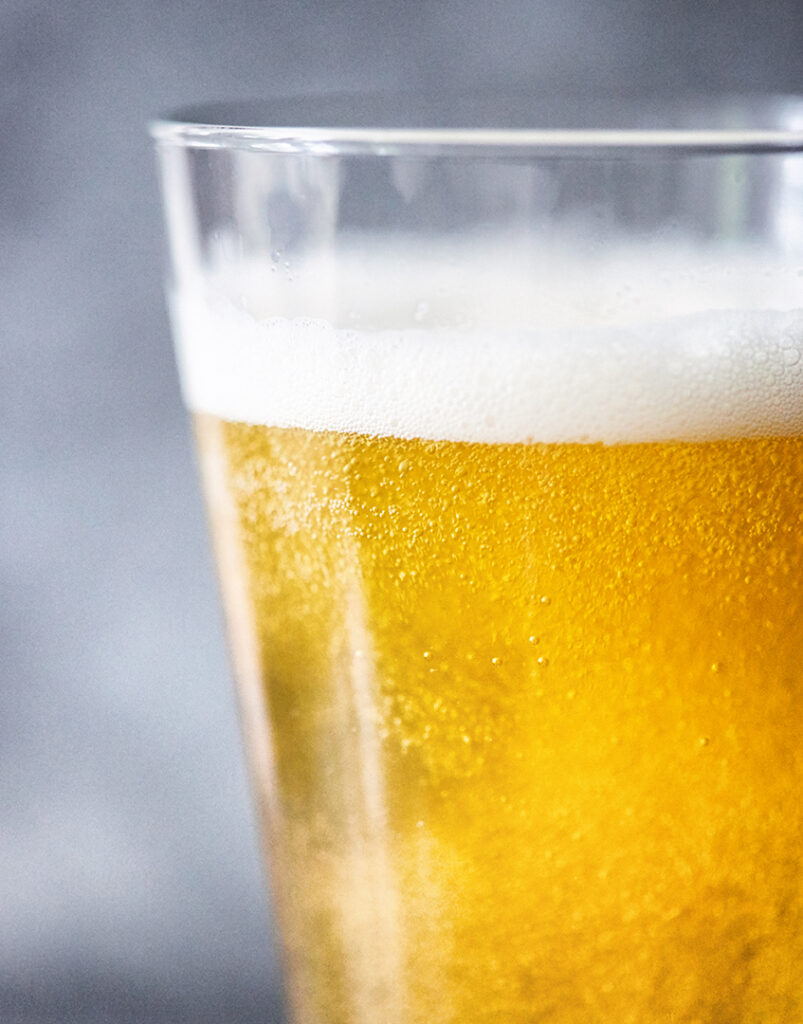
Other uses for Coriander
Coriander and Beer
Commercial breweries and keen homebrewers use coriander to add a lemony, slightly spicy flavour and aroma to beer. Commonly used in Belgian ales, especially Witbiers. A popular craft beer flavour combination is coriander seed and orange peel.
Coriander and Gin
Coriander is the second most used botanical in gin making, second to juniper. After distillation, the seed’s citrus, nutty and spicy flavour gives gin one of its most recognizable aromas and taste.
Coriander medical uses
In the practice of Ayurvedic medicine, coriander seeds are good for digestion, increasing appetite, overall body strength, immunity against allergens and help to purify the blood.
Coriander commercial uses
In commercial production, coriander is used to flavour medicines and tobacco and as a fragrance in cosmetics and soaps.

Coriander Seed Substitute
Cumin Seeds – Cumin with its woody earthy taste lacks the citrus element of coriander seeds, however, combining it with some finely grated orange rind will provide a fairly good substitute.
Fresh coriander leaves can be added towards the end of cooking or used as a garnish as a substitute for coriander seeds.
Caraway seeds are in the same family as coriander and will give a similar taste. Only a small amount is required as a substitute as caraway’s strong taste and smell can overpower a dish very quickly.

Recipes using Coriander
Below is a selection of sweet and savoury recipes using coriander seeds
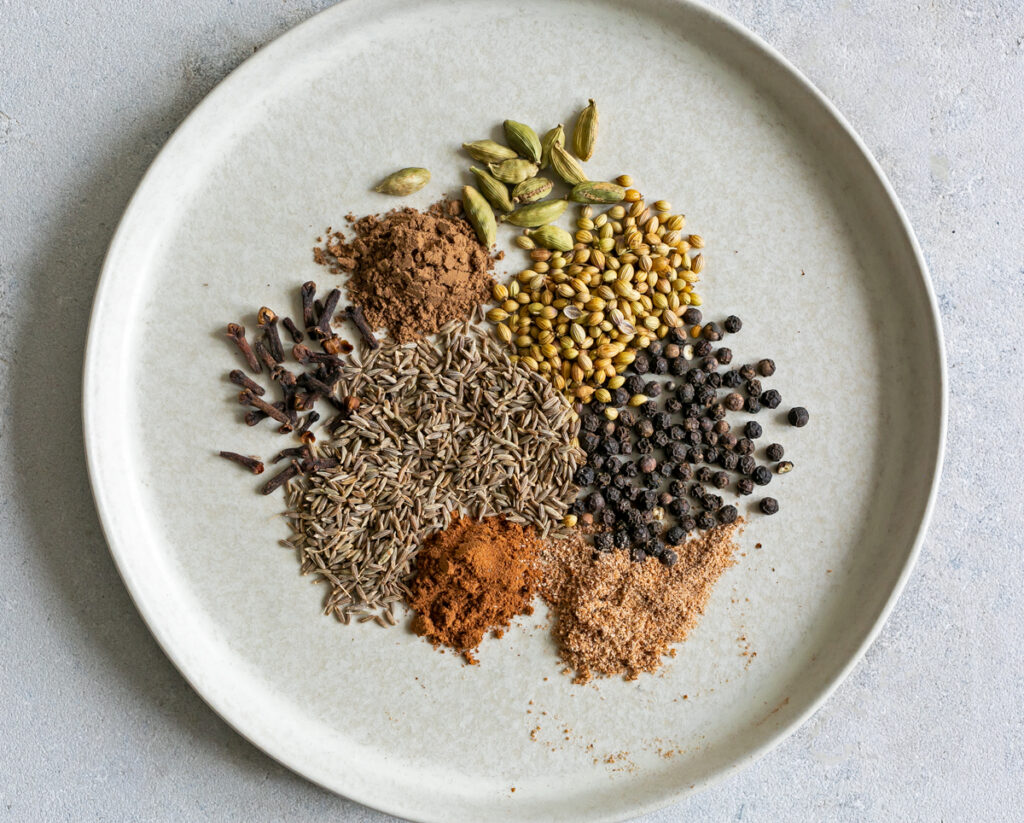
Baharat Spice Blend
This famous Middle Eastern spice blend made with black pepper, cardamom, cloves, cumin, nutmeg, coriander and paprika is used in a huge variety of traditional recipes or modern fusion dishes. Recipe here

Harrisa Paste
Harissa Paste is a hot aromatic spice blend from North Africa consisting of red chillies, cumin, coriander, caraway, garlic, smoked paprika, salt, fresh garlic, lemon juice and oil. Recipe here

Spiced Ricotta Honey Toast
Whole coriander seeds are dry roasted along with cumin and fennel and crushed down with a touch of chilli. The spice mix is then sprinkled over creamy ricotta toast drizzled with honey. Recipe here
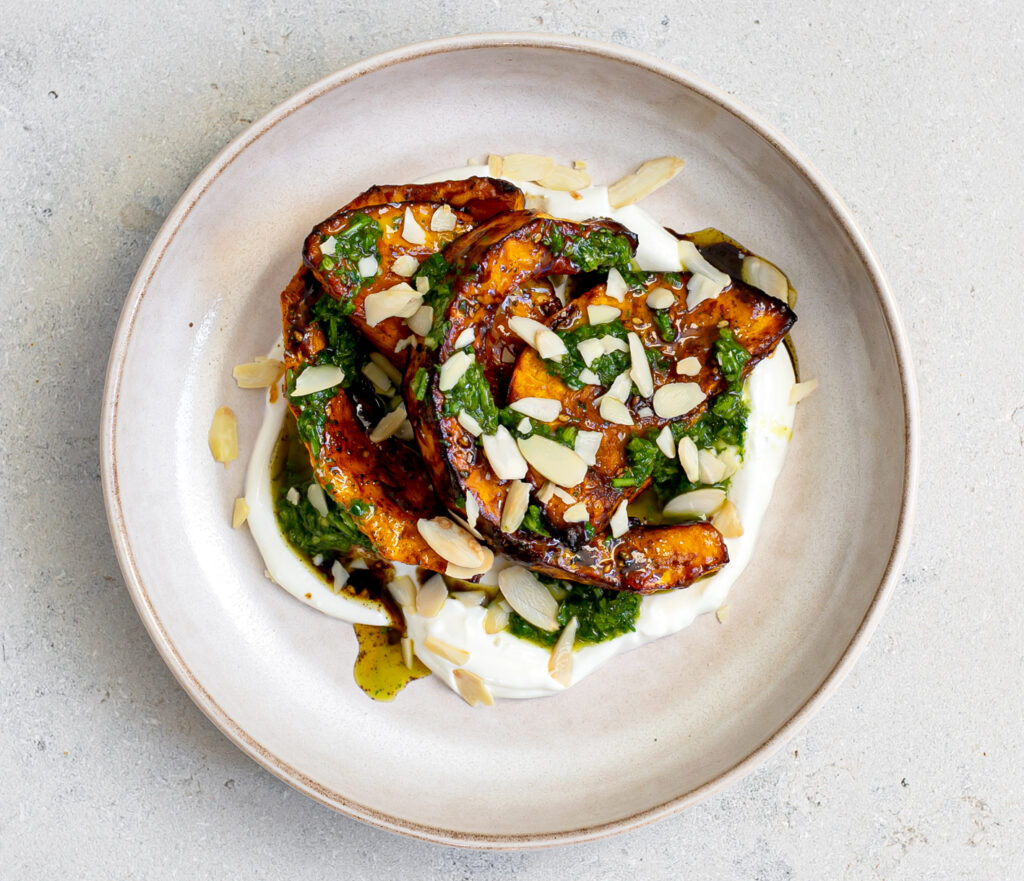
Spiced Pumpkin with Coriander Sauce
Doubling up on the coriander here using both the seeds and fresh leaves as garnish. This hearty pumpkin recipe combines soy-cinnamon-maple syrup, fresh lime and coriander salsa layered on refreshing cold yoghurt. Recipe here
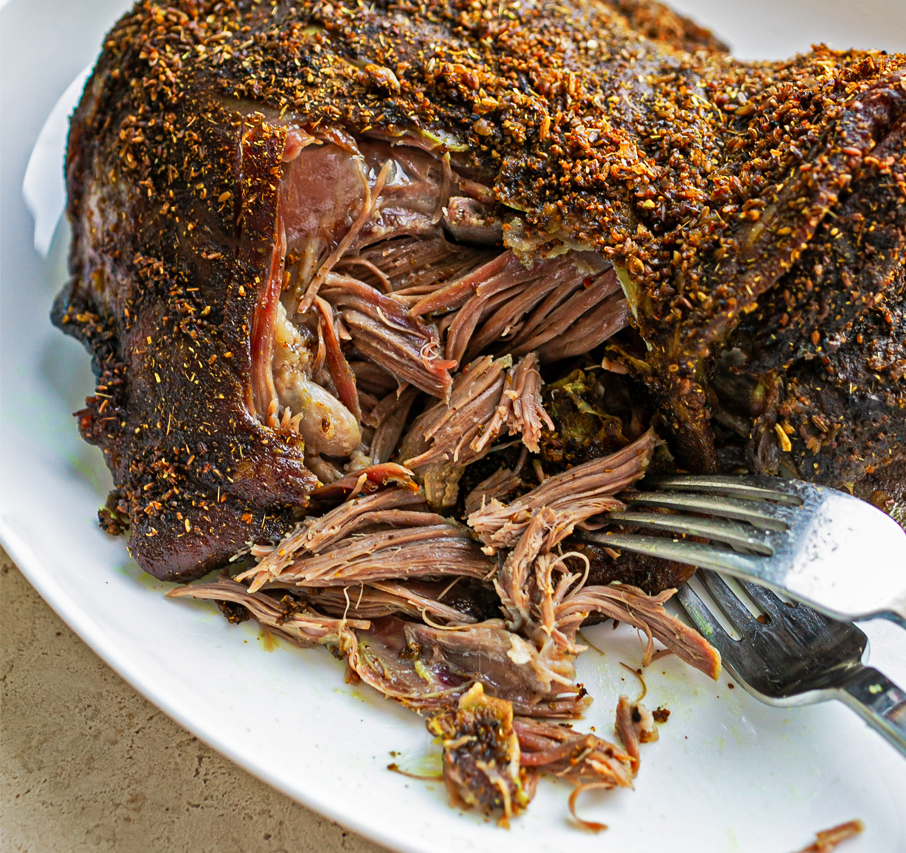
Slow-Roasted Madras Lamb Shoulder
This beautiful cut of lamb on the bone is enhanced by an Indian Madras curry spice rub using coriander seeds and fennel. Recipe here
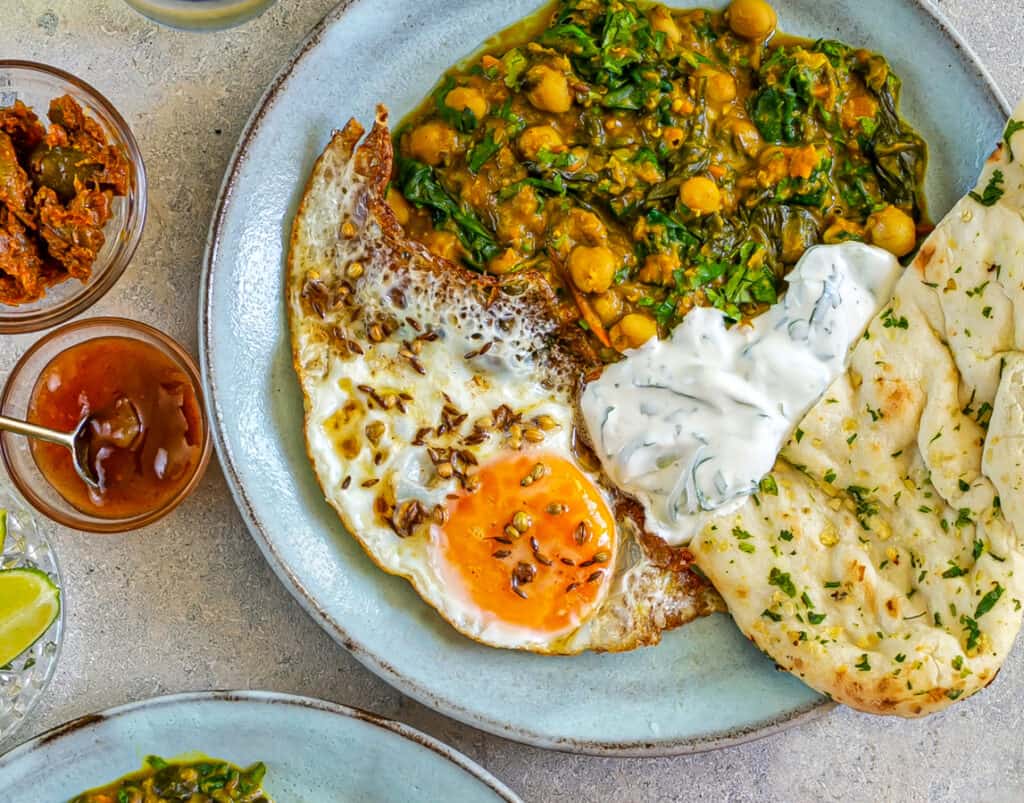
Chickpea Spinach Curry with Fried Eggs
The inspiration for this dish comes from Chana Saag, a classic vegetarian Indian curry made with chickpeas, spinach, onion, tomato, ginger, garlic, and warm spices. Paired with fried eggs and cooling coriander yoghurt, serve it as a weekend breakfast or brunch. Recipe here
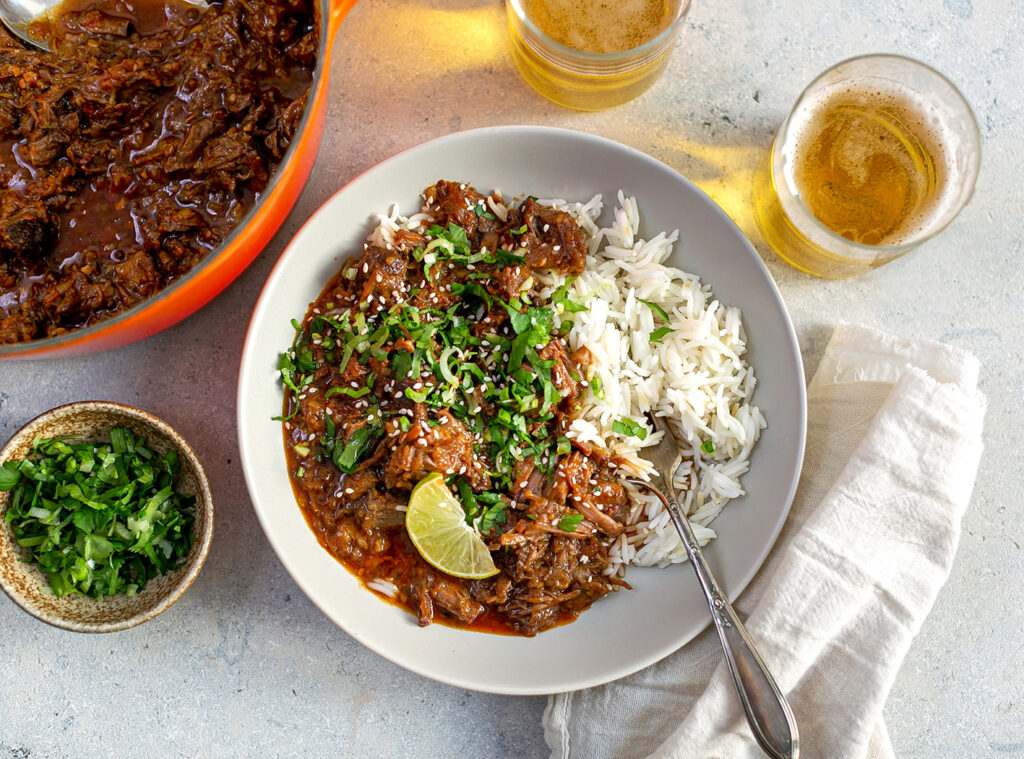
Beef Gochujang Stew
A spice mix of coriander, Sichuan pepper, ginger and Korean gochujang chilli paste creates a wonderful multi-layered base in this warming comforting beef stew. Slow-cooked to perfection resulting in a rich juicy meat sauce with a spicy kick: Recipe here
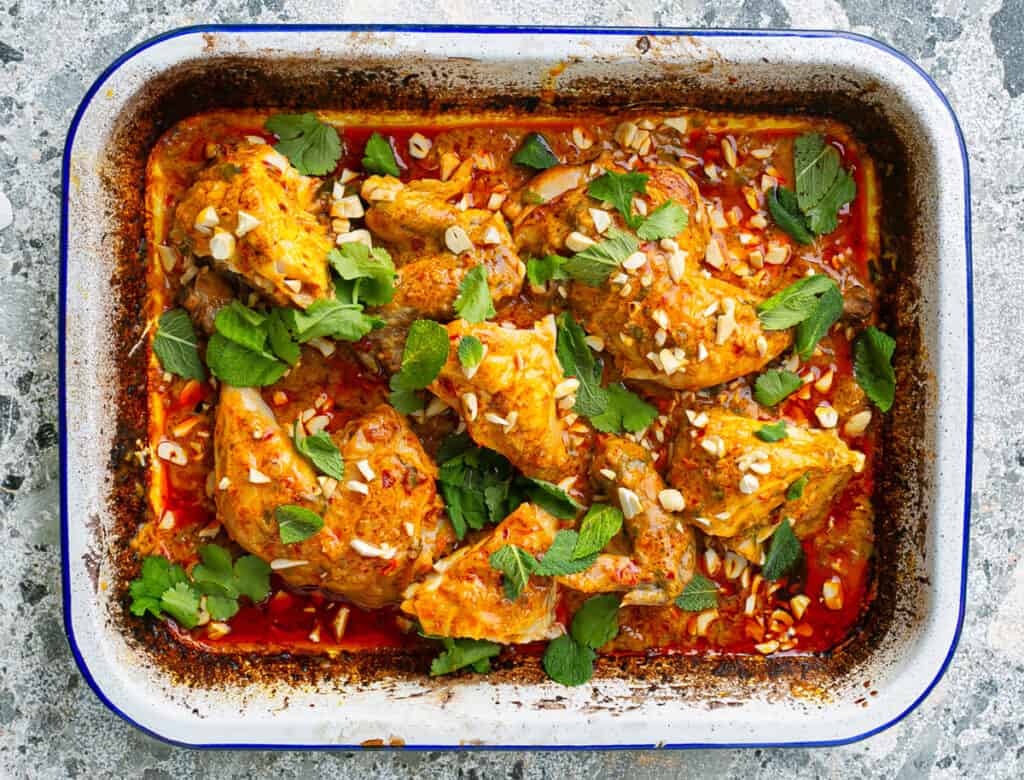
One-Pot Roasted Chicken Lemongrass Curry
Roasted chicken in a thick curry sauce created with an effortless one-pot cooking method. Rich with fresh flavours of coriander, lemongrass, lime leaves, cooling coconut milk and garnished with fresh coriander and mint leaves. Recipe here
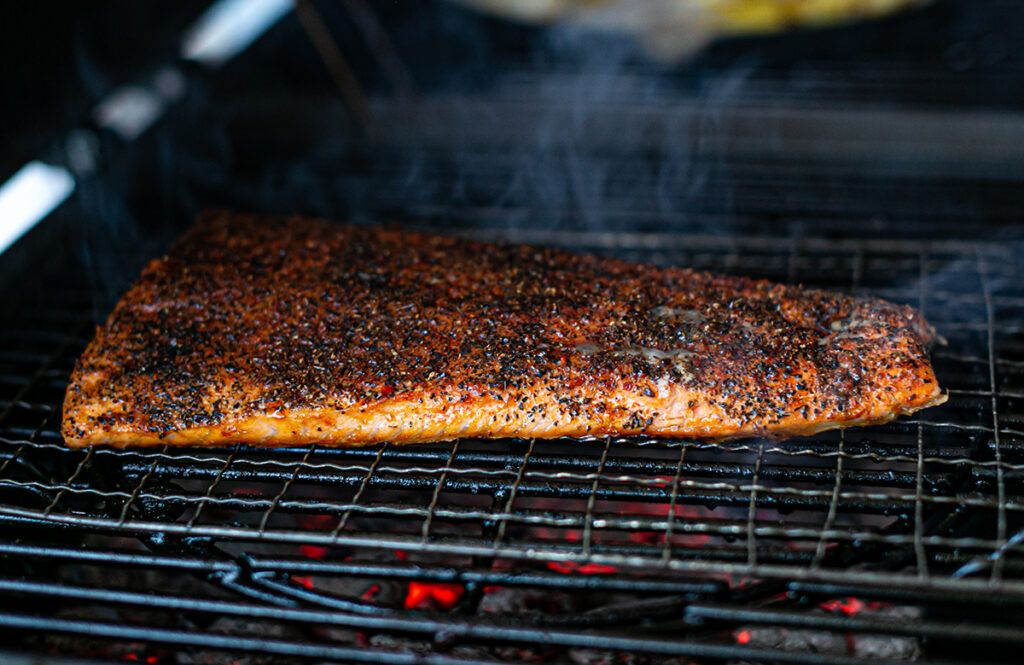
BBQ Spice Rubbed Salmon
Whole salmon fillet rubbed in smoked paprika, cumin, coriander, fennel, chilli powder and sumac then smoked on a coal-fired BBQ. Served with a delicious fresh summery charred green feta sauce full of coriander, mint and lime juice. Recipe here
 Where to buy: Purchase online or at your local spice store
Where to buy: Purchase online or at your local spice store

